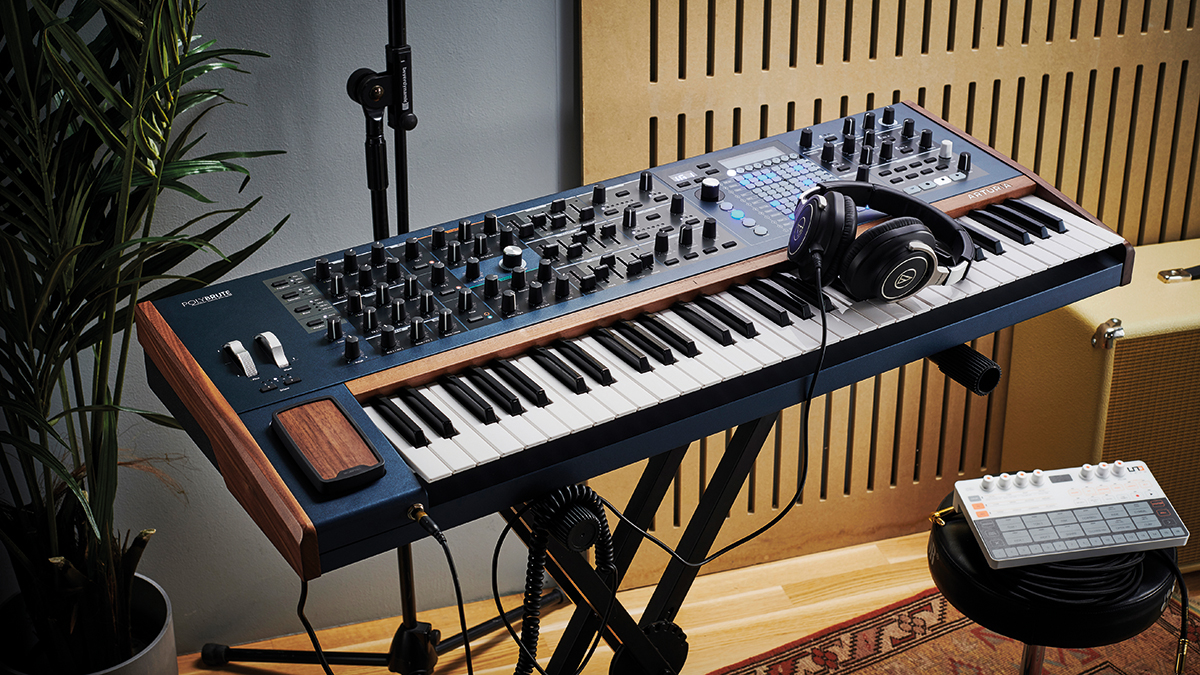MusicRadar Verdict
The PolyBrute is a fantastically characterful, well-designed synth; a top-tier poly and a worthy flagship for the Brute range.
Pros
- +
Morphing engine is fantastic for creating evolving, complex sounds.
- +
Hands-on modulation matrix is, once again, a great design choice.
- +
Digital effects sound excellent.
Cons
- -
No audio input or CV I/O.
- -
Only six voices.
- -
No poly-aftertouch.
MusicRadar's got your back
What is it?
News of an Arturia polysynth wasn’t a total surprise. Since the early-’10s, the French brand’s lineup of synths has grown to encompass budget analogue (MicroBrute), semi-modulars (MiniBrute 2/2S), a behemoth monosynth (MatrixBrute) and eccentric digital synthesis (MicroFreak). Their 20th anniversary seemed an obvious moment to unveil a new flagship instrument.
You may spot the similarities between the PolyBrute and MatrixBrute; most obviously in the inclusion of a similar button matrix, but also in the general architecture. Although it wouldn’t really be accurate to describe this synth simply as a polyphonic MatrixBrute, it’s not entirely baseless.
Like the MatrixBrute, the PolyBrute is a digitally-controlled analogue synth combining multiple VCOs and VCFs with a powerful modulation matrix, sequencer and arpeggiator. The MatrixBrute’s distinctive dual filter setup is carried across here too, which pairs Steiner Parker and Ladder Filter designs that can be positioned in series or parallel.
There are key differences to the hardware itself. Unlike the MatrixBrute, the control panel is in a fixed position, so it can’t be angled-up Minimoog style. While the 61-key velocity and aftertouch-equipped keyboard is essentially the same as its monophonic counterpart, the PolyBrute adds additional expressive tools to the mix, with a ribbon controller subtly indented above the keyboard and a new three-dimensional expression pad labelled ‘Morphee’.
This latter element is like a simplified version of Expressive E’s Touché controller, with a touch-sensitive wooden panel that allows users to apply modulation by depressing the panel or dragging a finger across the x or y axis.
These modulation sources can be applied to almost any synth parameter using the matrix [see Matrix Reloaded], and while the Morphee and ribbon controller don’t entirely negate the presence of traditional pitch and mod wheel – also included here – they’re excellent additions that are likely to have even seasoned synth players expressing themselves in new ways.
There are a few I/O differences between the Matrix and PolyBrute too. Here we get master stereo outputs plus a headphone output, along with MIDI in, out and through, USB MIDI, analogue pulse sync in and out and three pedal inputs (sustain and two expression). Unlike on the MatrixBrute, there’s no CV connectivity here though, and no audio input either, so there’s no way to run external sounds through those dual filters or the effects.
Want all the hottest music and gear news, reviews, deals, features and more, direct to your inbox? Sign up here.
- The 21 best high-end hardware synthesizers
- The 11 best semi-modular synths
- The best cheap synthesizers for smaller budgets
Matrix reloaded
The MatrixBrute’s titular button matrix makes a return here, in a more compact, 12x8 form. Functionally, it fulfils the same roles, acting as a handy preset browser, a controller for the multi-lane sequencer and, most usefully, a digital patchbay for assigning and editing modulation routings.
For the PolyBrute, 12 modulation sources are fixed down the left-hand side of the grid, and up to 32 modulation routings can be freely assigned across four banks along the top row.
Editing modulation patches is a simple case of holding the relative grid button and twisting a knob to apply the required depth. While modulation routings themselves are fixed for both A and B states of each patch, the depth of each can be morphed so, combined with the ability to assign up to 64 modulation patches for each sound, you can morph between two entirely different modulation setups within a single patch.

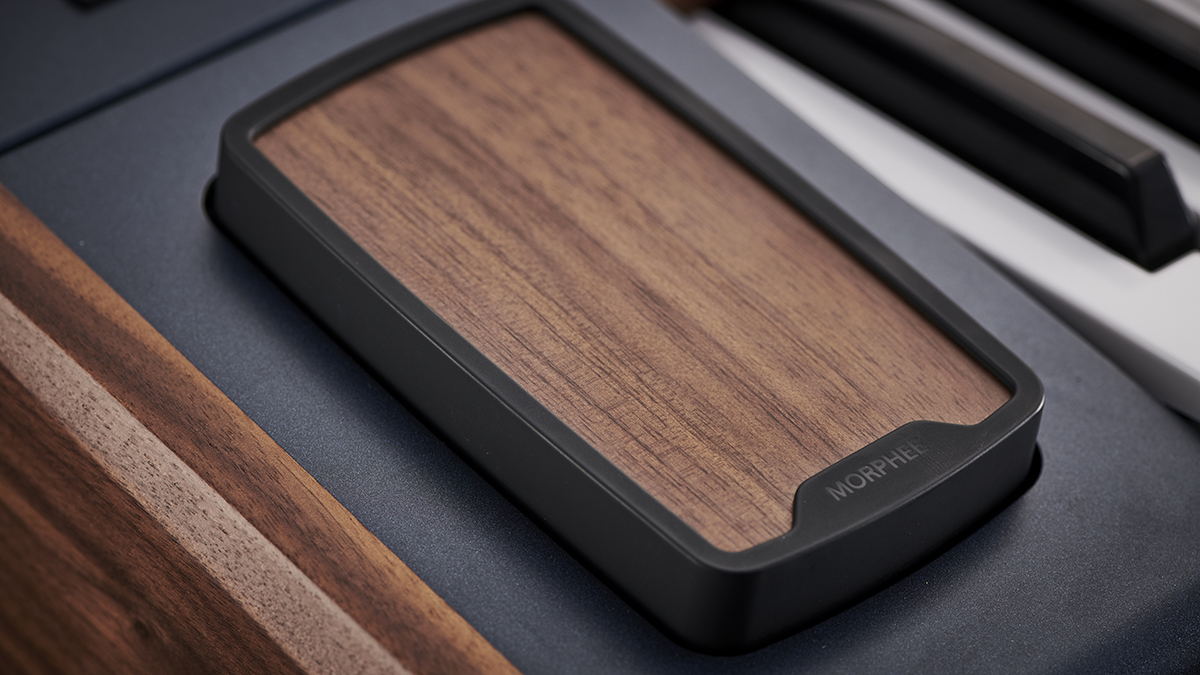
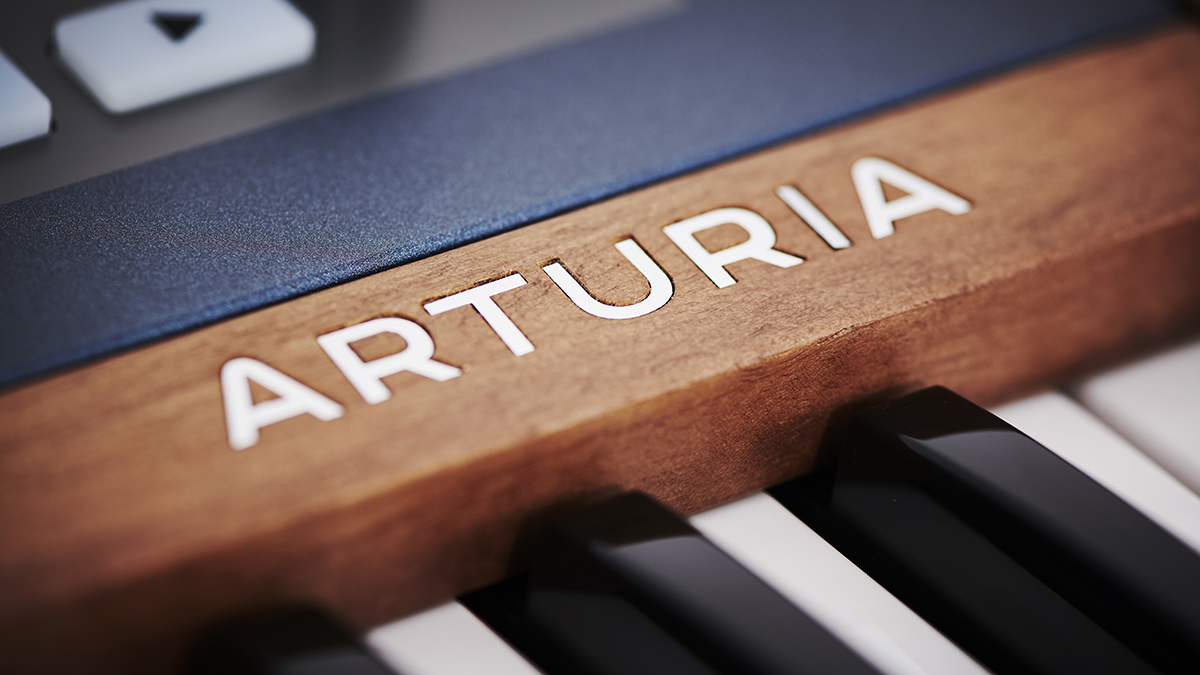

Performance and verdict
The PolyBrute is a six-voice instrument so it’s far from the most polyphonic synth in its price range. It is multitimbral though, with the ability to set up two distinct sounds at once (labelled A and B).
With a few exceptions, every synth parameter can be assigned separate A and B states and, rather than simply switching between the two, the PolyBrute uses a rotary to allow gradual blends of the two setups. In its standard Morph mode, rather than simply switching or fading between two static sounds, the synth will smoothly transition each affected parameter from its A state to its B state.
So if you have an oscillator tuned to -12 semitones in state A and +12 semitones in state B, rather than hearing the lower-pitched sound blend with the higher one, morphing from A to B will result in an audible rise in pitch as the osc moves from one state to the other.
Since the PolyBrute uses a rotary rather than a switch to flip between A and B states, editing sounds isn’t simply a case of selecting one sound or the other. With the rotary hard over to side A or B, parameter adjustments will only affect the selected sound, but any position between the two means that edits are made to each state proportionally, with the dead centre position adjusting both equally.
This can occasionally make setting up sounds a little confusing – it’s easy to get carried away tweaking osc or filter settings without remembering to check on the position of your morph dial first. Fortunately, Arturia has included a number of smart tools to speed up assigning A and B sounds, including options to swap or duplicate sounds, to assign the current settings to slot A or B, regardless of Morph rotary position.
While each PolyBrute preset includes both A and B states within the patch, you can mix-and-match states from multiple presets, which can be a really inspiring way to try out sounds.
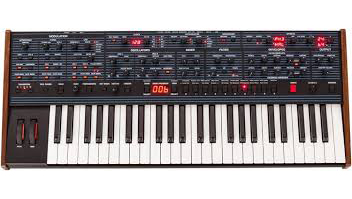
• Sequential OB-6
Incorporating a similar voice count and continuous morphing oscillators, this Dave Smith/Tom Oberheim collaboration nails a broadly similar sonic spectrum.
• Novation Summit
Novation’s 16-voice synth similarly combines elements of analogue and digital to create something unique and characterful.
• Arturia MatrixBrute
Arturia’s mono/ paraphonic synth uses the same excellent modulation matrix and similar engine design, but has a grittier, more aggressive character.
Along with the standard 6-voice Morph mode, the PolyBrute also has layer and split functions. In layer mode, polyphony becomes three-note with two voices stacked one on top of the other. In this mode, the morph rotary adjusts the balance between A and B across these layers.
In split mode, two sounds can be laid out across the keyboard with a variety of range and voice configurations. Here the lower part is assigned the static A state, while the upper can be morphed between the two.
The knock-on effect of this engine design is that many sound parameters that might have been controlled by switches or faders are here controlled by continuous rotaries allowing them to morph between settings. The oscillators, for example, use a pair of rotaries to control the balance of each VCO’s saw, triangle and square outputs.
There are also rotaries for blending in osc sync and cross-modulation. In the filter section, the Steiner filter has a morphing mode rotary that can smoothly change between low-pass, high-pass and band-pass modes.
Most interestingly, control for adjusting the routing of two filters between serial and parallel setups – controlled by a switch on the MatrixBrute – is handled by a continuous rotary letting the synth slowly transition between routing setups.
The way the oscillators are routed into the two filters can be set individually for states A and B, so you can morph slowly between two totally different osc/filter configurations.
The PolyBrute has a number of other interesting tools up its sleeves. Modulation is provided by a trio of envelopes and a trio of LFOs, all flexible in their own right. Of most interest though is a new curve LFO, reminiscent of the rise/fall function generators found on West Coast-style modular synths, a really nice addition.
The effects section here is excellent too. The PolyBrute ditches the analogue effects of the MatrixBrute for three digital effects modules covering modulation effects, delay and reverb.
The quality is universally high; many of the effect types use algorithms found in Arturia’s excellent effects bundles and Pigments softsynth, and really suit the kind of big synth patches PolyBrute excels at. The effects can act as either inserts or sends, and the latter mode works particularly well coupled with the modulation or morphing tools for adding quick bursts of reverb or delay.
Another nice touch is the addition of a stereo spread rotary, which can be used to adjust the PolyBrute’s voices across the stereo field to add width.


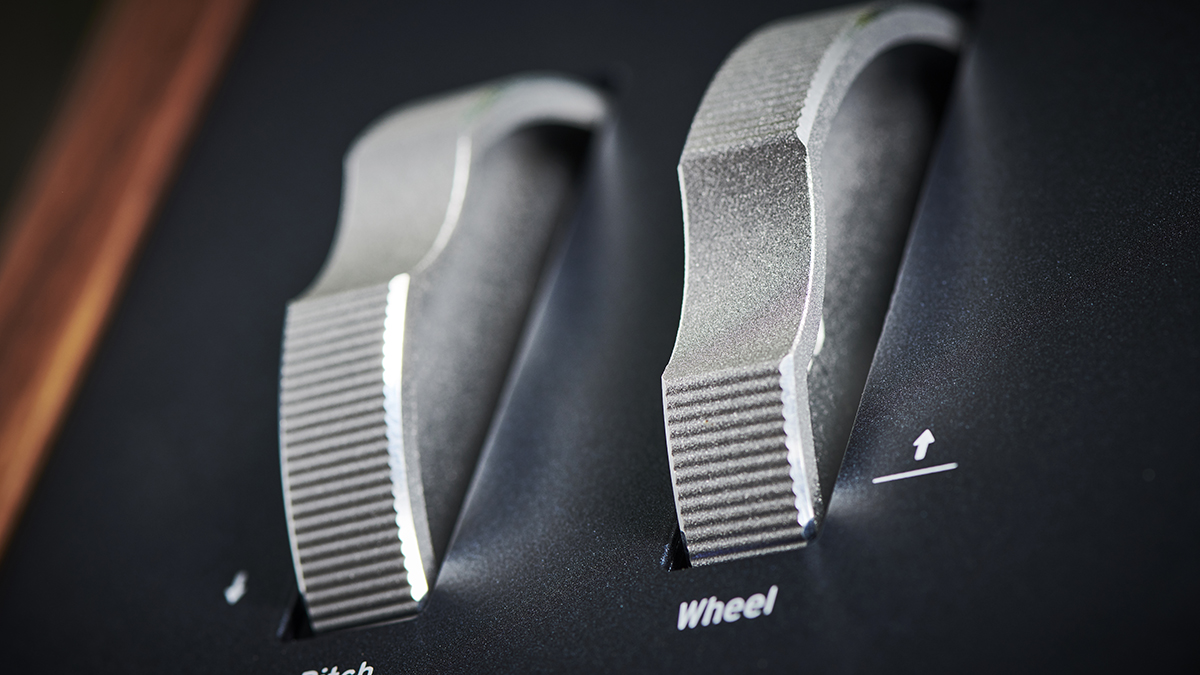
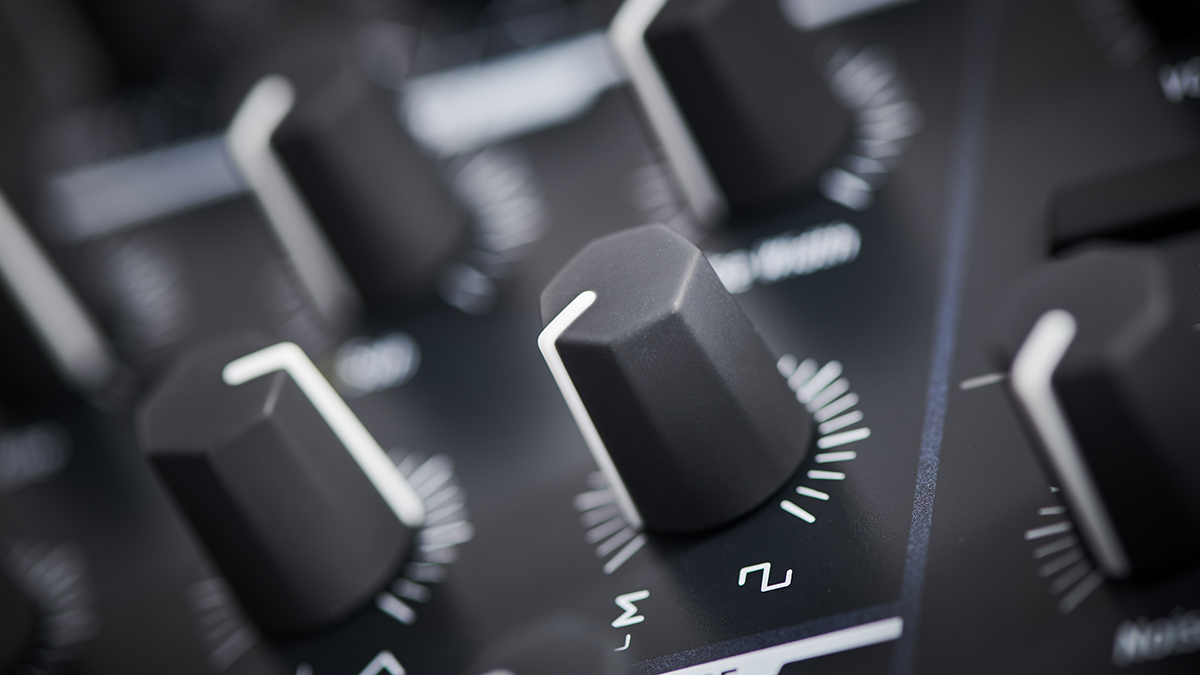
The PolyBrute packs both a sequencer and arpeggiator, which are fairly conventional but both very well-equipped; the sequencer has three modulation tracks for capturing parameter automation, and can program accents and slides via the central matrix. More unique is the Motion Recorder. This lets users record automated movement for any one control, which can then be re-triggered with each note played either as a loop or one-shot modulation envelope.
This can work for simple parameters like filter cutoff or resonance sweeps, but also to automate movement from ‘macro’ controls like the morph knob or expression controllers. The results are surprisingly complex and reminiscent of the evolving wave sequenced sounds of Korg’s classic Wavestation.
It’s these modulation and morphing tools that give the PolyBrute its character. The MatrixBrute was distinctive for its hard-edged leads; while there’s still grit here via filter drive and the now-standard Brute Factor and Metalizer parameters, the PolyBrute leans towards complex, evolving sounds full of subtle timbral shifts.
While it’s versatile, capable of unison leads, frequency-filling basses, FX and classic analogue chords, the synth is best when using its morphing capabilities to create patches that can shift from creamy to metallic with a twist of the mod wheel.
The design is largely stellar too. The button matrix is the star here; it’s pleasantly simple to keep track of complex modulation patches and quickly hop between presets. There’s also a forthcoming desktop editor application, which promises full DAW control.
It’s a shame Arturia have ditched both the audio input and CV connectivity found on other Brutes, but understandable given the setup of the polyphonic synth engine, although CV outputs from the sequencer would have been a nice touch.
Overall though, this is an excellently designed, characterful synthesizer deserving of a place among the top tier of polysynths.
MusicRadar verdict: The PolyBrute is a fantastically characterful, well-designed synth; a top-tier poly and a worthy flagship for the Brute range.
Hands-on demos
BoBeats
Loopop
Arturia
MusicRadar
Specifications

- TYPE: 6-voice digitally-controller analogue polysynth.
- KEY FEATURES: Multitimbral morphing engine, virtual modulation patchbay, three digital effect modules, 61-note keyboard equipped with velocity and aftertouch sensitivity.
- CONTACT: Arturia

I'm the Managing Editor of Music Technology at MusicRadar and former Editor-in-Chief of Future Music, Computer Music and Electronic Musician. I've been messing around with music tech in various forms for over two decades. I've also spent the last 10 years forgetting how to play guitar. Find me in the chillout room at raves complaining that it's past my bedtime.
